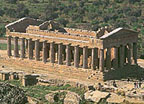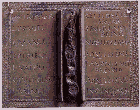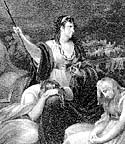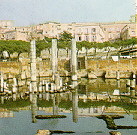 A white sandstone lioness statue unearthed by ferryman Robert Graham in the mud of the River Almond in 1997 is expected to form the centrepiece of a new £2 million interpretative center planned for Cramond, Scotland. Plans have also be proposed to restore the 1800-year-old Roman fort near Cramond Kirk and the nearby bath house.
A white sandstone lioness statue unearthed by ferryman Robert Graham in the mud of the River Almond in 1997 is expected to form the centrepiece of a new £2 million interpretative center planned for Cramond, Scotland. Plans have also be proposed to restore the 1800-year-old Roman fort near Cramond Kirk and the nearby bath house.
Herbert Coutts, city director of culture and leisure, said it was one of only three permanent sites known to be associated with the Severan conquest of Scotland.
The fort also played a crucial role in supplying provisions to other Roman garrisons, said Mr Coutts, while Mesolithic remains at the site were also significant. 'The post-Roman and early medieval remains are scant, but are also of national importance and high significance, not least due to the gap in knowledge about the use of the fort site following the departure of the Romans.' "
 "Located on a plateau overlooking Sicily's southern coast, Agrigento was founded as Akragas around 582 BC by a group of colonists from Gela, who themselves were the immediate descendants of Greeks from Rhodes and Crete. Akragas was renamed Agrigentum by the Romans, and Girgenti by the Saracens, only to be christened Agrigento in 1927, but the place is the same.
"Located on a plateau overlooking Sicily's southern coast, Agrigento was founded as Akragas around 582 BC by a group of colonists from Gela, who themselves were the immediate descendants of Greeks from Rhodes and Crete. Akragas was renamed Agrigentum by the Romans, and Girgenti by the Saracens, only to be christened Agrigento in 1927, but the place is the same.
 "Archaeologists have uncovered the earliest examination certificate ever found in Britain. Fragments of two bronze sheets, which had been threaded together, were unearthed by metal detector enthusiasts in Norfolk.
"Archaeologists have uncovered the earliest examination certificate ever found in Britain. Fragments of two bronze sheets, which had been threaded together, were unearthed by metal detector enthusiasts in Norfolk.
 "Archaeologists from Wessex Archaeology found a small cremation cemetery from London's earliest years that had been severely disturbed some time before the 70s - the date is given by a coin overlying the site.
"Archaeologists from Wessex Archaeology found a small cremation cemetery from London's earliest years that had been severely disturbed some time before the 70s - the date is given by a coin overlying the site.
 "For centuries passers-by have thrown rocks at an ornate tomb in Jerusalem's Kidron Valley, reviled as the traditional burial place of the biblical King David's villainous son Absalom.
"For centuries passers-by have thrown rocks at an ornate tomb in Jerusalem's Kidron Valley, reviled as the traditional burial place of the biblical King David's villainous son Absalom.
 "Discovered entirely by accident in 1840 during road construction, the hypogeum in Perugia (2nd century BC), is the biggest of the 38 graves found in the surrounding Palazzone burial ground.
"Discovered entirely by accident in 1840 during road construction, the hypogeum in Perugia (2nd century BC), is the biggest of the 38 graves found in the surrounding Palazzone burial ground.
 "Excavators at Pompeii, entombed in ash and toxic debris by the eruption of Mount Vesuvius in AD 79, were able to remove the volcanic material and expose the city to the open air.
"Excavators at Pompeii, entombed in ash and toxic debris by the eruption of Mount Vesuvius in AD 79, were able to remove the volcanic material and expose the city to the open air.
 "The British Government has placed a temporary export ban on a Roman statue of Venus in the hope that it can be bought for the nation. The marble statue, described as being of "outstanding significance", has been dated to circa late 1st/mid-2nd Century AD and is a Roman copy of a Hellenistic original of 2nd Century BC. Known as Jenkins Venus, the statue, originally bought in Rome in 1765 , was resold at auction earlier in the year by an anonymous foreign buyer for a record £7.9m to pay for the refurbushiment of Newby Hall in North Yorkshire .
"The British Government has placed a temporary export ban on a Roman statue of Venus in the hope that it can be bought for the nation. The marble statue, described as being of "outstanding significance", has been dated to circa late 1st/mid-2nd Century AD and is a Roman copy of a Hellenistic original of 2nd Century BC. Known as Jenkins Venus, the statue, originally bought in Rome in 1765 , was resold at auction earlier in the year by an anonymous foreign buyer for a record £7.9m to pay for the refurbushiment of Newby Hall in North Yorkshire .
 "For the ancient Romans, looking good didn't stop at applying makeup. Archaeologists have found tools such as tweezers for trimming the brows and small scoops for cleaning out the ears. The devices were likely used by both men and women, says Rosenberg."
"For the ancient Romans, looking good didn't stop at applying makeup. Archaeologists have found tools such as tweezers for trimming the brows and small scoops for cleaning out the ears. The devices were likely used by both men and women, says Rosenberg."
 "The ancient palace in Rome that provided the backdrop for many of Emperor Caligula's wildest depravities has been found by British and American archaeologists. It has been located at the foot of the Palatine Hill, at a point where it met and joined the Temple of Castor and Pollux.
"The ancient palace in Rome that provided the backdrop for many of Emperor Caligula's wildest depravities has been found by British and American archaeologists. It has been located at the foot of the Palatine Hill, at a point where it met and joined the Temple of Castor and Pollux.